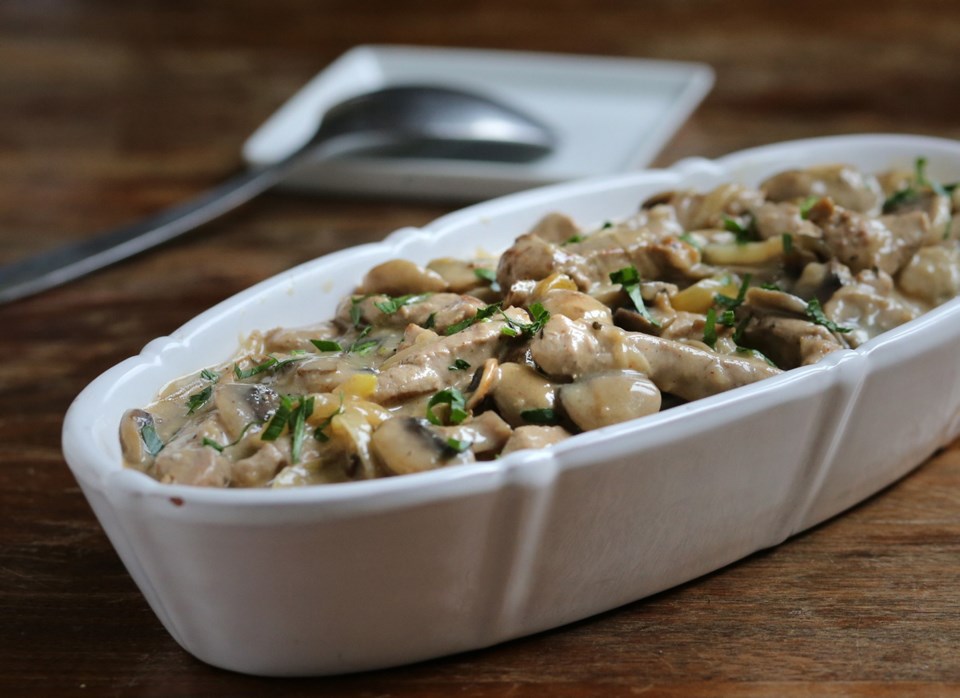 It’s lean, boneless, tender and moderately priced. You might think I’m talking about boneless, skinless chicken breast, but in this case, the meat is pork tenderloin.
It’s lean, boneless, tender and moderately priced. You might think I’m talking about boneless, skinless chicken breast, but in this case, the meat is pork tenderloin.
I don’t cook with it often, only because I don’t think to use it. But when I do, I’m always reminded of its culinary flexibility.
Not surprisingly, given its name, pork tenderloin is the most tender cut of pork. It’s cut from the bottom (inside part) of the loin, starting near the centre top of the animal and running back through the sirloin end, at the top of the back leg.
It’s also lean. Pork tenderloin is almost as low in saturated fat as boneless, skinless chicken breast.
Before cooking pork tenderloin, remove the silverskin, a silvery, tough connective tissue that runs along the top of the flesh.
Starting about 2.5 centimetres from either end of the tenderloin, slide your sharp, thin-bladed knife under a strip of it. Use your non-cutting hand to hold the silverskin taut and then, with your knife angled upward, slide it down the tenderloin to remove it.
The pork tenderloin is now ready to use. To show you that culinary flexibility, I’ve provided three ways to cook it.
The first involves roasting the tenderloin whole with Chinese-style flavourings. Another recipe requires you to cut and form the tenderloin into medallions that you grill and flavour with minty orange sauce. In the third option, you cut the pork into strips and use it in place of beef in a wonderful stroganoff.
Pork Stroganoff
Strips of pork tenderloin in a creamy mushroom sauce. Serve it over buttered egg noodles or steamed rice.
Preparation: 30 minutes
Cooking time: About 25 minutes
Makes: four servings
1 whole pork tenderloin (about 500 grams), trimmed of any fat and silverskin
2 Tbsp vegetable oil
• salt and fresh ground black pepper
2 Tbsp butter
1/2 medium onion, diced
1/2 lb. white mushrooms, sliced
1 medium garlic clove, minced
3 Tbsp flour
1/4 tsp paprika
1/4 tsp dried thyme
2.5 cups chicken stock
1/4 cup sour cream
1 Tbsp chopped fresh parsley
Cut the pork widthwise, at a slight angle, into 1.5-centimetre-thick slices. Now cut each pork slice lengthwise into 1.5-centimetre-thick strips. Season the pork with salt and pepper.
Heat the oil in a large non-stick skillet set over medium-high heat. Sear the pork strips, in batches, until golden brown, and then transfer to a plate.
Now, add the butter to the skillet. When melted, add onion, mushrooms and garlic and cook until the mushrooms are tender, about five to six minutes. Mix in the flour, paprika and thyme and cook two minutes more.
While stirring, slowly mix in half a cup of the stock. When the mixture is thick, mix in the rest of the stock. Bring the sauce to a simmer and cook five minutes. Whisk the sour cream into the sauce and add salt and pepper.
Mix in the pork, return to a simmer and cook two to three minutes. Serve portions of the pork sprinkled with parsley.
Pork Medallions with Minty Orange Ginger Sauce
In this recipe, medallions of pork are flavoured with an appealing and easy-to-make sweet-and-sour sauce.
Preparation: 20 minutes
Cooking time: About 15 minutes
Makes: two servings
1 small pork tenderloin (about 375 grams), trimmed of any fat and silverskin
1 Tbsp vegetable oil
• salt and freshly ground black pepper
1/3 cup orange marmalade (see Note)
1 tsp chopped fresh ginger
2 Tbsp orange juice
1 Tbsp soy sauce
1 Tbsp cider or rice vinegar
1 Tbsp water
2 Tbsp chopped fresh mint
Cut the pork widthwise into four equal pieces. Place one of the pieces of the pork on a cutting board and cover with plastic wrap. Firmly press on the pork with the palm of your hand and form into a medallion about two centimetres thick. Repeat with the remaining pieces of pork. Brush the medallions with the oil and then season with salt and pepper.
Preheat your barbecue or indoor grill to medium-high. When it’s hot, grill the pork three to four minutes per side, or until just cooked through. Set the pork on a plate and cover with aluminum foil.
To make the sauce, place the marmalade, ginger, juice, soy sauce, vinegar and water in a skillet and bring to a simmer. Simmer and whisk until the marmalade is melted and a lightly thickened sauce forms. Season the sauce with pepper and, if needed, salt. Now mix in the mint.
Add the pork to the skillet, turn to coat with the sauce, and heat through two minutes. Set two pork medallions on each of two plates, top with sauce and serve.
Note: I used Robertson’s brand Scotch orange marmalade when testing this recipe.
Eric’s options: If you don’t have a grill, you could pan-sear the pork medallions in hot oil in a skillet for a similar amount of time.
Chinese-Style Barbecue Pork Tenderloin
Lacquered-looking, aromatic, delicious pork can be sliced and served as an appetizer or as a main course with steamed rice and stir-fried vegetables. This pork can also be sliced or diced and added to Chinese-style dishes, such as fried rice, noodles, stir-fries and soups.
Preparation: 20 minutes, plus marinating time
Cooking time: 35 minutes
Makes: six to eight servings
2 Tbsp brown sugar
2 Tbsp soy sauce
2 Tbsp hoisin sauce
2 Tbsp ketchup
2 Tbsp rice vinegar
1 Tbsp sesame oil
1 tsp five-spice powder
2 medium garlic cloves, minced
1 Tbsp finely chopped ginger
2 pork tenderloins (each about 400 grams), trimmed of any fat and silverskin
1 cup chicken stock or beer
2 green onions, thinly sliced
Combine the first nine ingredients in a dish with sides just large enough to hold the pork.
Add the pork and turn to coat. Cover, refrigerate and marinate pork for four to eight hours, turning occasionally.
Preheat the oven to 375 F. Set a cooking rack over a sided baking pan. Set the pork on the rack. Pour the stock or beer into the bottom of the pan. Brush the pork with half the remaining marinade in the dish (see Note). Roast the pork for 20 minutes.
Brush the pork with the remaining marinade and roast 15 to 20 minutes more, or until just cooked through. Place the pork on a plate, tent with aluminum foil and rest for 10 minutes. Pour the juices in the pan into a small pot and set over low heat.
Thinly slice the pork and arrange on a platter. Drizzle the juices in the pot over the pork, sprinkle with green onions and serve.
Note: The heat of the hot oven will destroy any bacteria from the raw meat that seeped into the marinade. Any pork you don’t eat now will freeze well and be ready to thaw and use in the Chinese-style dishes noted in the recipe introduction.
Eric Akis is the author of The Great Rotisserie Chicken Cookbook (Appetite by Random House). His columns appear in the Life section Wednesday and Sunday.



